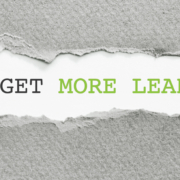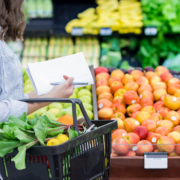Generating leads can be a challenge for any client, especially those in a niche market. And, coming up with a working strategy can take time. In 2021, ad impressions on Facebook increased by 34% (Siu, 2021). With this increase of activity in the Facebook Ads space, the opportunity to reach your next business lead becomes greater. Here are some best practices for generating quality leads that you can follow up on.
A whopping 28% of OG shoppers made their first ever online grocery order in March due to COVID19”1. These shoppers, who’ve adopted OG out of necessity, represent a new demographic in the space.
The landscape for grocery is rapidly changing. As retailers struggle to adapt, supplier marketing teams are often left to find innovative ways to drives sales and strengthen loyalty on their own. The landscape for grocery is rapidly changing. As retailers struggle to adapt, supplier marketing teams are often left to find innovative ways to drives sales and strengthen loyalty on their own…
Everyone talks about micro-moments and wants to win more of them. But these rich opportunities on the path to purchase are short lived and often elusive to marketers. So you need to be ready at the right time with the right solution, but how do you actually do it?
Location data is a shiny object, but marketers often get perplexed with how to start using it, or simply dive in without a plan. Yet the building blocks of a geofencing advertising strategy are super simple. So let’s look at 3 easy steps to jumpstart your geofencing strategy…
Chad Bingle, Director of Media here at Mediavision2020, sat down with Jarrod Davis and the 8th & Walton crew to talk about how to strategically develop a geofencing media campaign. Listen to the full podcast conversation or grab the notes below!
Basic Elements of Geofencing
- Targeting location: Geofencing is targeting people based on their location, typically that of their mobile device
- Area: A geofence is simply a defined area on a map: circle or polygon, and anyone inside that geofence is your target audience. That basically translates to a set of coordinates
- Size: A geofence can be any size, but is typically most effective around a specific building or within a section of a building (like a section of a store).
Geofencing Isn’t Just One Technique, It Has Many Facets To It
- Unique Functions of Geofencing
- Real-time advertising (in geofence now)
- Retargeting advertising- really effective for when you want to build a custom retargeting audience where where they have been in the recent past is a salient layer of data.
- Attribution & analytics
- Context for Geofencing
- Shopping: in-store & conquesting
- In-home: individual devices or entire households
- Lifestyle: Concerts, Sports Events, etc.
- B2B: Offices, Conferences, Trade Shows
- Reach: Device vs Cross-device & Household
Common Geofencing Mistakes to Avoid
Everyone geofences, but all geofences aren’t created equal. There are a few red flags to watch for when crafting or evaluating a geofencing plan.
- Irrelevant or Missing Call to Action. If you’re going to go through the effort of targeting, make it worth it. Just pushing information/impressions: not having anything relevant at that point in time. A conquesting campaign should have a robust, exclusive offer that’s time sensitive. If you’re a CPG company, your geo-retargeting campaign should try to engage shoppers while they’re between grocery trips and planning their list.
- Wrong timing: Doing real-time by default when retargeting would make more sense
- Too broad of targeting: Just b/c location targeted doesn’t mean you’re relevant.
- Targeting an entire area around a big box store where everyone is there for different reasons, for example.
- Location isn’t always enough to reach the right audience.
- Layered data for better relevance (think: data sandwich)
- Measurement: What’s your goal? If geo-conquesting, did you drive click-to-call actions or visits to your store? If you’re influencing consideration, did you run a controlled test and see positive comparative sales for your test group within a given timeframe? While geofencing can be challenging to measure with accuracy, it’s possible to at least measure it consistently and do it in a controlled test.
When Geofencing Is Right, When It’s Not The Best Fit
When it’s right:
- Location = relevance: When your geofenced actually helps you reach your target audience in a meaningful way, where location = relevance, not just coincidence
- Conquesting (goal of growing share): lower ROAS requirements, open to aggressive approach
- Influencing consideration, offer exclusive content or offers
- Enrich targeting of current behavioral campaigns or complement other media tactics like search and behavioral.
- Bridging ecommerce and in-store through retargeting
When it’s not the best fit:
- Bottom-funnel: Goal of immediate lead gen or sales gen with a lower CPA
- Location = Irrelevance: Location is not aligned to intent
- No value added, nothing unique about reaching them through location targeting
GEOFENCING ARTICLES & VIDEOS
- Best 35 IP address targeting companies & IP targeting marketing providers
- Winning at Lead Generation is all about optimization – here’s a sniff of the secret sauce
- Walmart+ is in PRIME position to win over holiday shoppers.
- Who are the new online grocery shoppers?
- Meet Lauren, the new home cook – Emerging Shopper Profiles
- The Online Grocery Surge: Recipes for Success
- Leveraging Mobile ID Capture Technology During COVID-19
- 3 key strategies that will help you connect with first-time online grocery shoppers
- Accelerate Your Online Grocery Delivery Media Machine
- Last Brand to Grocery Delivery is a Rotten Egg
HOW WE VERIFY OUR RESULTS
Our Geofencing campaigns are able to track visitors who see your ad - then visit your location. No other ad technology provides this level of 1:1 attribution for measuring ROAS and campaign performance. Using our GeoConquesting tactics, we even track visitors who were at your competitors location - then visit your location.
IP TARGETING - SALES RESULTS
Our IP Targeting campaigns are measured by comparing the homes that saw your ad - directly with your sales results. This match-back process allows you to precisely measure your ROAS. In fact, in is not uncommon for us to see over 25X return on ad spend for IP Targeting campaigns in the auto and furniture industries.





